Story at a glance:
- Sustainable plumbing aims to reduce a building’s overall environmental impact through a combination of eco-friendly materials and water- and energy-efficient fixtures.
- Using green plumbing solutions helps to conserve water, reduce waste, prevent water shortages, and lower a building’s operating costs.
- Some strategies—like rainwater-fed systems and integrated gray water recycling—force us to reconsider how we design and think about plumbing.
Many green building strategies focus on clean energy retrofits or energy-efficient upgrades, but there’s another crucial piece of building systems we must not ignore—their plumbing networks.
The need for sustainable plumbing solutions—and specifically those that prioritize water conservation—is obvious when one considers the increasing frequency and severity of both droughts and heat waves. By the year 2025 it’s estimated that water shortages arising from these conditions will affect over half of the world’s population, putting billions at risk of death by dehydration and heatstroke.
Fortunately there is much that can be done to improve plumbing infrastructure and facilitate conscientious water use in the built environment. In this article we’ll cover the basics of sustainable plumbing, its benefits, and explore 10 popular sustainable plumbing solutions.
What is Sustainable Plumbing?
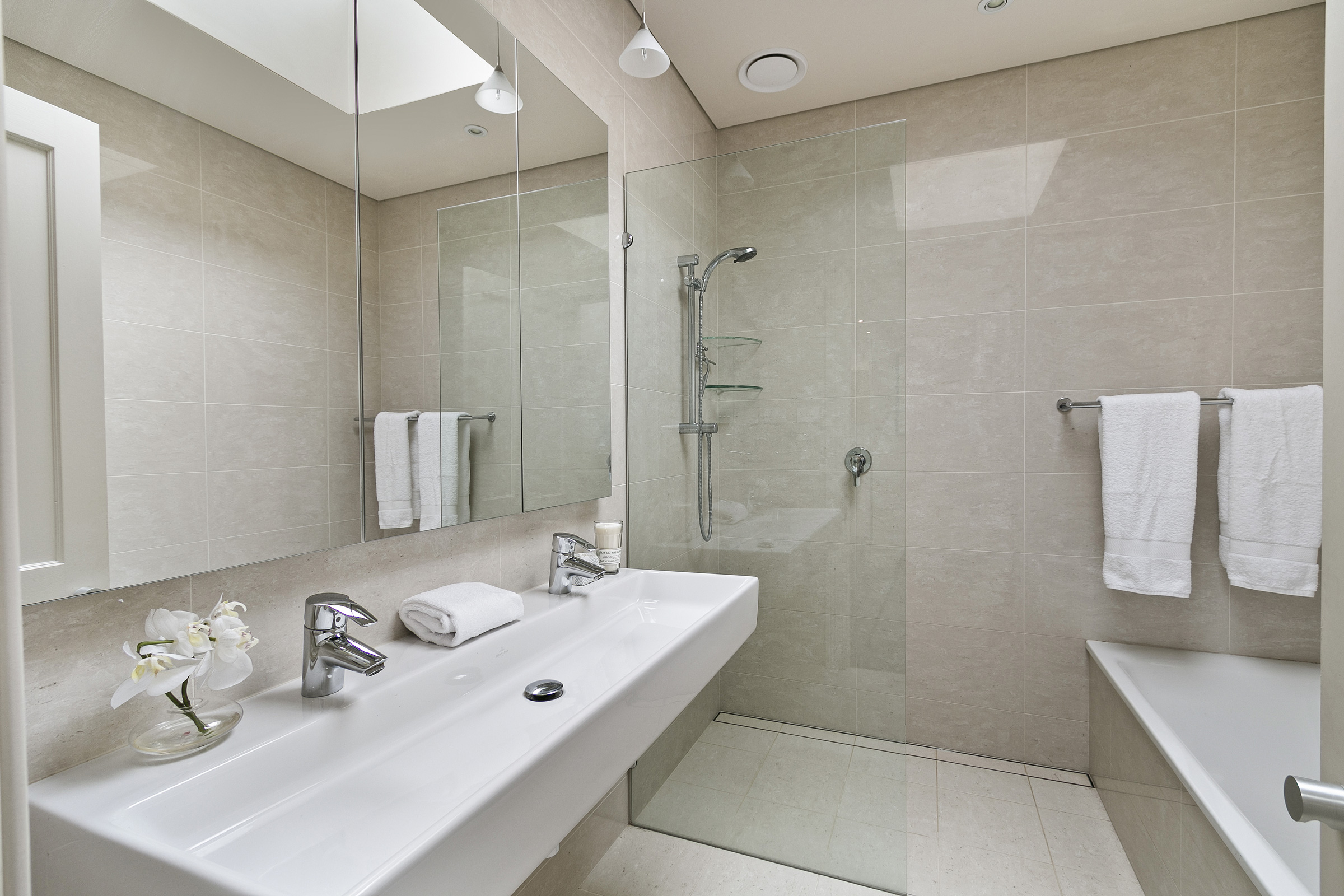
Photo courtesy of Oatey Co.
Sustainable plumbing describes those plumbing systems that use a combination of green building materials and improved technology to reduce a building’s overall environmental impact, chiefly by way of water conservation, reduced energy waste, and responsible material use.
Most sustainable plumbing solutions focus on improving the water and energy efficiency of conventional plumbing system components, while others—such as rainwater-fed systems and integrated gray water recycling—force us to reconsider how we think about plumbing design in general.
Plumbing System Anatomy
Before we start exploring sustainable plumbing solutions, let’s explore the basic anatomy of a conventional plumbing system, of which typically include the following elements:
- Pipes. Responsible for the movement of all water—both fresh and wastewater—throughout a building’s plumbing system.
- Valves. Control and regulate the flow of water in a plumbing system; valves can be shut off in the event of a leak or a burst pipe.
- Fixtures. The physical components that actually dispense or drain water (e.g. faucets, showerheads, drains).
- Water Heater. Responsible for heating the water that is then delivered to various fixtures and appliances.
- Water Meter. Measures the amount of water consumed by a building; used to calculate utility bills and monitor water efficiency.
- Water Pressure Regulator. A device used to regulate a plumbing system’s water pressure and prevent damage caused by high water pressure; typically located near the main water supply.
- Drainage System. Drainage systems remove wastewater from a building’s main plumbing system and carry it to a sewer or septic system; wastewater is transported through pipes while vents serve to equalize the drainage system’s air pressure.
- Sewer/Septic System. As the final component in a building’s plumbing, a sewer system is responsible for removing wastewater from the premises and transporting it via a network of pipes to a municipal treatment facility; a septic system, on the other hand, removes the wastewater and treats it on-site before releasing it back into the environment.
Some plumbing systems will also include a backflow preventer, which serves to prevent contaminated water from flowing back into the system.
Benefits of Sustainable Plumbing
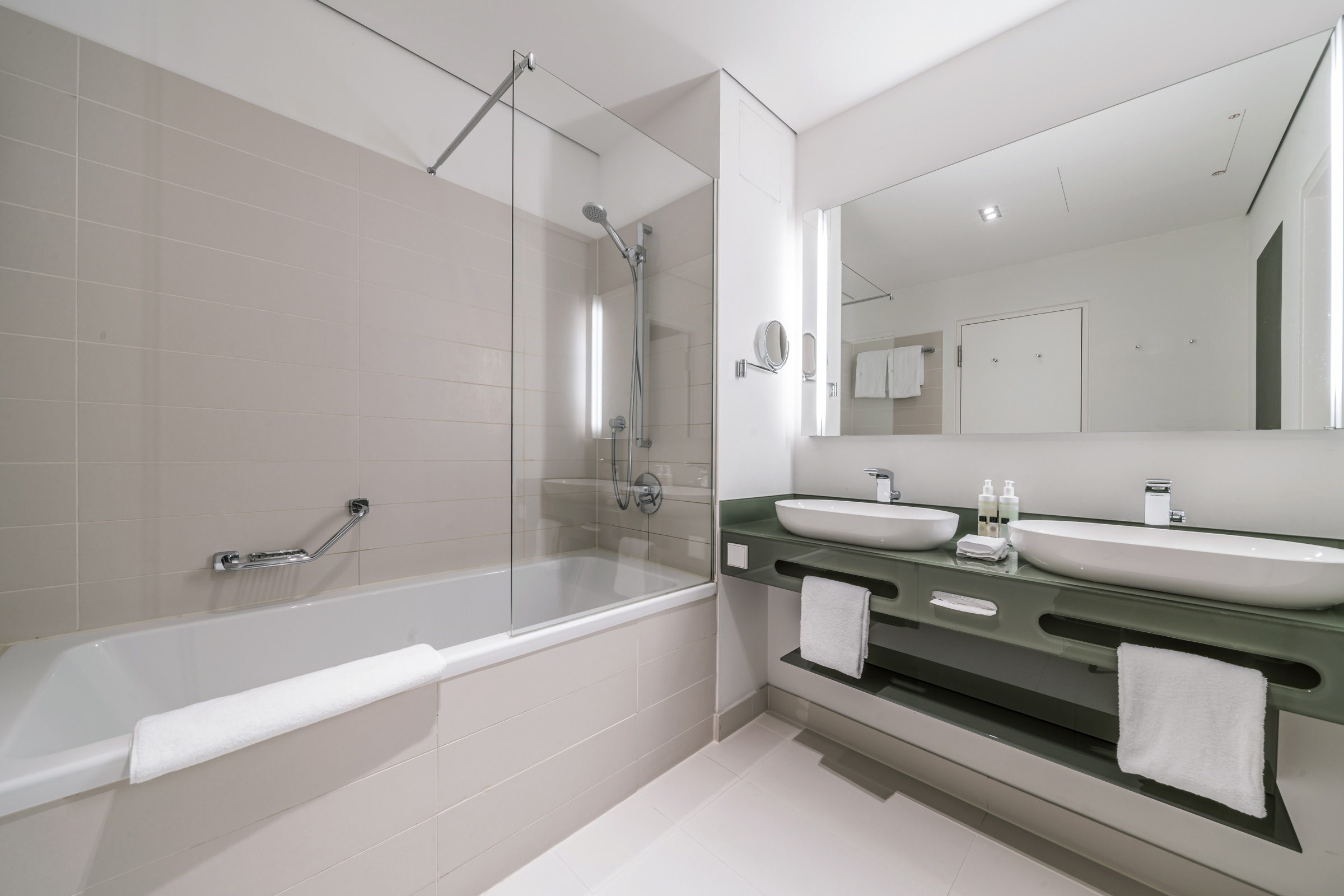
Sustainable plumbing solutions help conserve water, reduce waste, prevent water shortages, and lower operating costs. Photo courtesy of Oatey Co.
Making sustainable plumbing decisions is not only beneficial from an environmental standpoint but also helps property owners save money by reducing their utility expenses.
Conserves Water & Reduces Waste
As a nation the United States consumes 322 billion gallons of water each day, with roughly 47 billion gallons going towards the operation of buildings. The vast majority of that water, however, is improperly managed, resulting in significant water waste. Iit’s estimated that approximately 25% of all water that enters residential and commercial buildings is wasted.
Sustainable plumbing solutions like water-efficient fixtures and appliances help to conserve water by using less to begin with, while other strategies—such as recirculating hot water pumps and gray water recycling—reuse water that would otherwise be wasted.
Helps Prevent Water Shortages
When implemented at scale sustainable plumbing solutions that conserve water ultimately reduce demand on reservoirs and aquifers, helping to prevent water shortages during times of drought. This is especially important considering the world’s ongoing and ever-worsening water crisis—spurred on by increasing planetary temperatures and shifting climatic conditions—has put one fourth of the globe’s largest cities under water stress, stretching water-related infrastructure to its limit.
Approximately 80% of all state water managers in the US expect to have water shortages in the next decade, according to the EPA, with many states in the southwest already experiencing water shortages during the hottest months of the year. Sustainable plumbing solutions help prevent excessive water waste and ensure that communities are able to meet their water needs throughout the year.
Lower Operating Costs
Another benefit of sustainable plumbing is that it reduces a building’s operating costs. The average US household spends $876 annually on water and pays upwards of $1,740 in electric bills, with roughly 18% of that going towards water heating. All in all, water-related expenses cost the average household over $1,000 each year.
Sustainable plumbing solutions help lower these expenses by either reducing a building’s overall water use requirements (e.g. low-flow fixtures and pressure-reducing valves), reducing energy consumption by using less hot water (e.g. tankless water heaters and recirculating hot water pumps), or some combination of the two.
10 Sustainable Plumbing Solutions
Now that we’ve a better understanding of sustainable plumbing and its importance, let’s take a look at 10 popular sustainable plumbing solutions.
1. Low-Flow Toilets
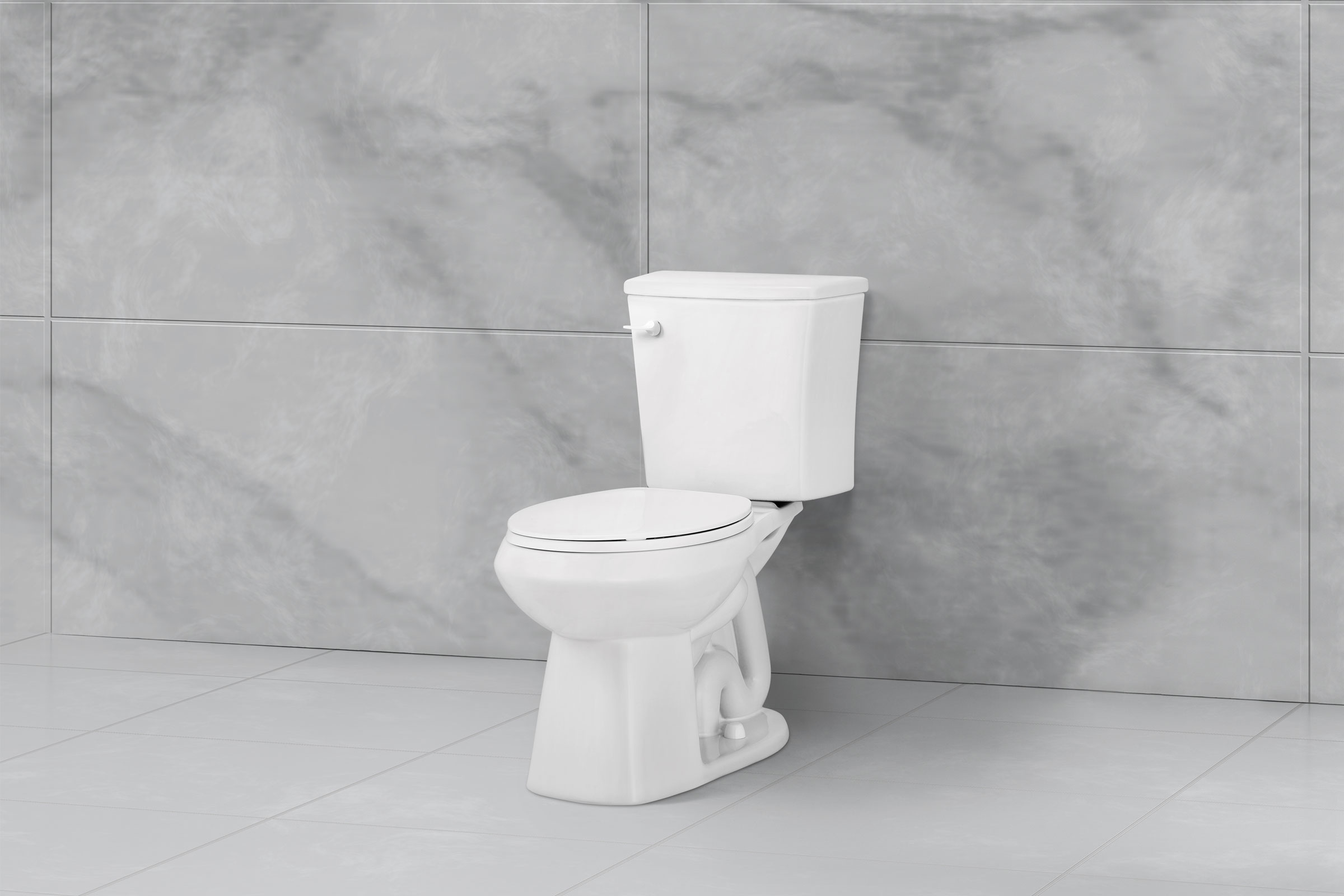
The type of toilet you choose contributes greatly to a project’s overall water efficiency. Photo courtesy of Niagara
Estimates suggest that toilets account for roughly 30% of a household’s daily water consumption, according to the EPA. To help your household conserve water consider replacing your toilet with a low-flow alternative, such as one produced by Niagara, a leading manufacturer of high-performance bathroom fixtures.
In compliance with plumbing standards set by the US government, low-flow toilets use no more than 1.6 gallons of water to flush. If your home was constructed after 1994, chances are you already have one installed. If you live in an older house with a toilet that was constructed before 1994, however, you may be using up to 7 gallons of water per flush, meaning an upgrade is in order.
Of course, not all low-flow toilets are as effective as others. If you’re serious about saving water, select a highly efficient toilet that consumes no more than 1.28 gallons per flush. Ultra-efficient low-flow toilets can be recognized by their WaterSense certification, which denotes that they have successfully completed stringent independent laboratory testing with regard to performance and efficiency.
2. High-Efficiency Faucets
According to the EPA the standard flow rate of most faucets is 2.2 gallons per minute (GPM), which is generally more water than most sinks require—and while sink faucets typically consume the least water out of all a building’s plumbing fixtures, there is still room for improvement in terms of their water usage.
High-efficiency WaterSense-certified faucets, for example, reduce a sink’s water flow by at least 30%, bumping the flow rate down to 1.5 GPM or lower without sacrificing performance (adequate water pressure) in the process. Faucet efficiency can also be improved through the addition of a WaterSense-labeled aerator, a type of screw-on faucet accessory that mixes air into the flow of water, thereby reducing the amount that actually passes through the tap.
3. Low-Flow Showerheads

A low-flow showerhead uses 2 gallons of water or less per minute, helping to save thousands of gallons each year. Photo courtesy of Oatey Co.
Standard shower heads typically use 2.5 gallons of water per minute, but you may be consuming far more depending on the kind of shower system you have installed (such as one with several showerheads).
Showerheads with the WaterSense low-flow seal of approval, however, use no more than 2 gallons of water per minute. Once installed it’s estimated that these fixtures can help household’s save 2,700 gallons annually. Furthermore, a low-flow showerhead will help reduce demand on your water heater, saving you money on energy bills.
4. PEX Pipes
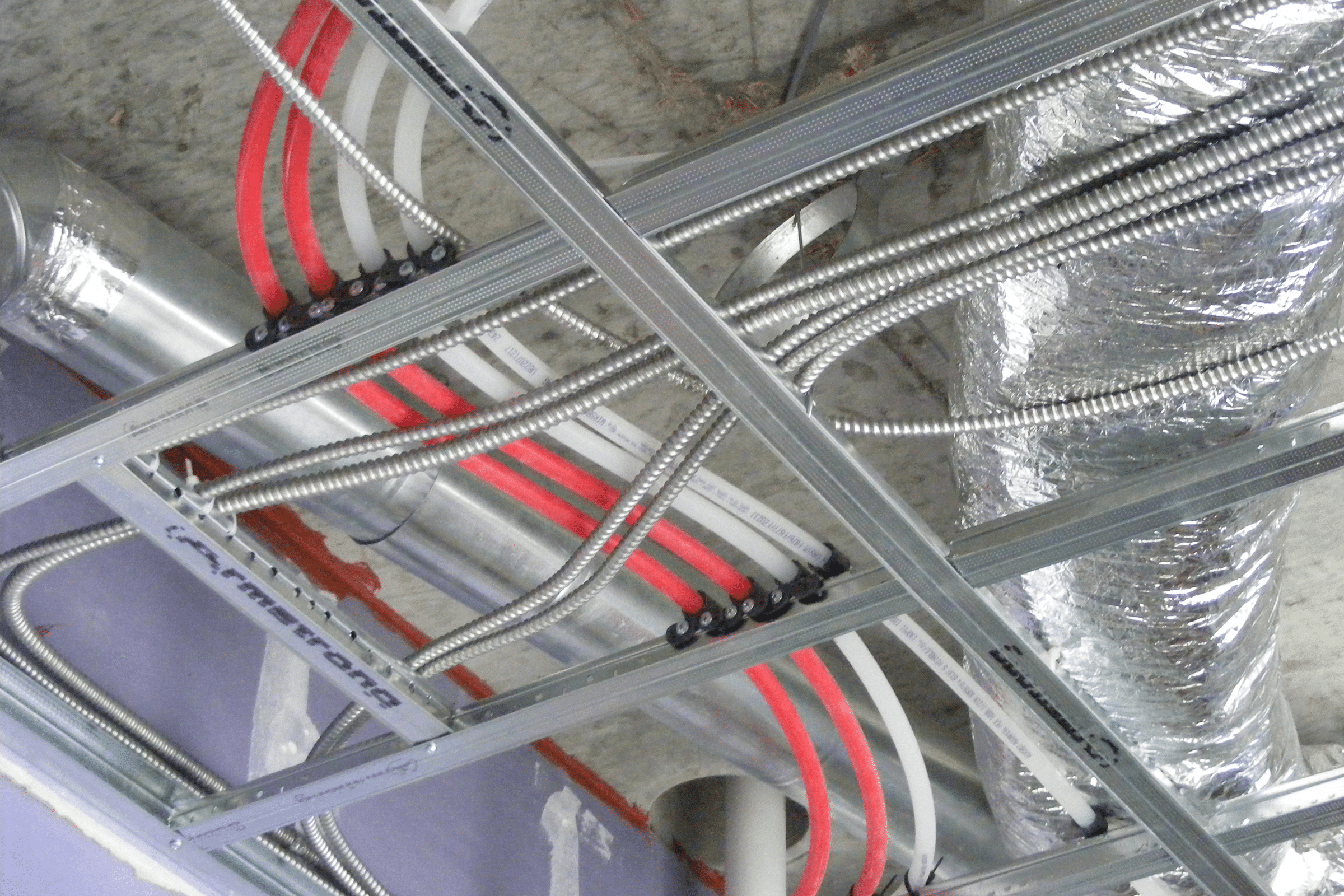
Because of its flexibility, PEX can bend around corners with each change of direction instead of having to add a connection. This reduces materials inside a building, while also improving water flow and reducing pressure loss for better system efficiencies and performance. Photo courtesy of Uponor
Sustainable plumbing solutions typically focus on reducing water usage and improving energy efficiency, but it’s also important to make smart material choices when manufacturing plumbing system components themselves. This is especially true of the pipes used to move water throughout a building, as they make up the majority of the plumbing system in terms of actual surface area.
Today PVC and copper are the most common pipe materials used in residential and commercial plumbing systems, respectively, but they are by no means the most sustainable. A 2008 life cycle inventory research project conducted by the Plastic Pipe and Fittings Association found that cross-linked polyethylene, or PEX, pipes have a lower lifetime impact than ABS, CPVC, PVC, polyethylene, and copper pipes.
PEX piping is extremely durable, is rust- and corrosion-resistant, and has an operational lifespan of approximately 100 years, greatly reducing the need for costly resource-intensive repairs and replacement work. PEX pipes are also incredibly flexible, a trait that allows them to bend around corners without the aid of connector pieces. “This reduces materials inside a building while also improving water flow and reducing pressure loss for better system efficiency and performance,” Devin Abellon, business development manager for engineering services at Uponor North America, previously wrote for gb&dPRO.
Uponor is one of the leading providers of PEX and uses sustainable manufacturing methods to reduce their overall environmental impact. Approximately 99% of the scrap material generated by the company is recycled and repurposed as filler for other products or is transformed via a clean incineration process to extract stored energy for heating purposes.
5. Drainage Systems
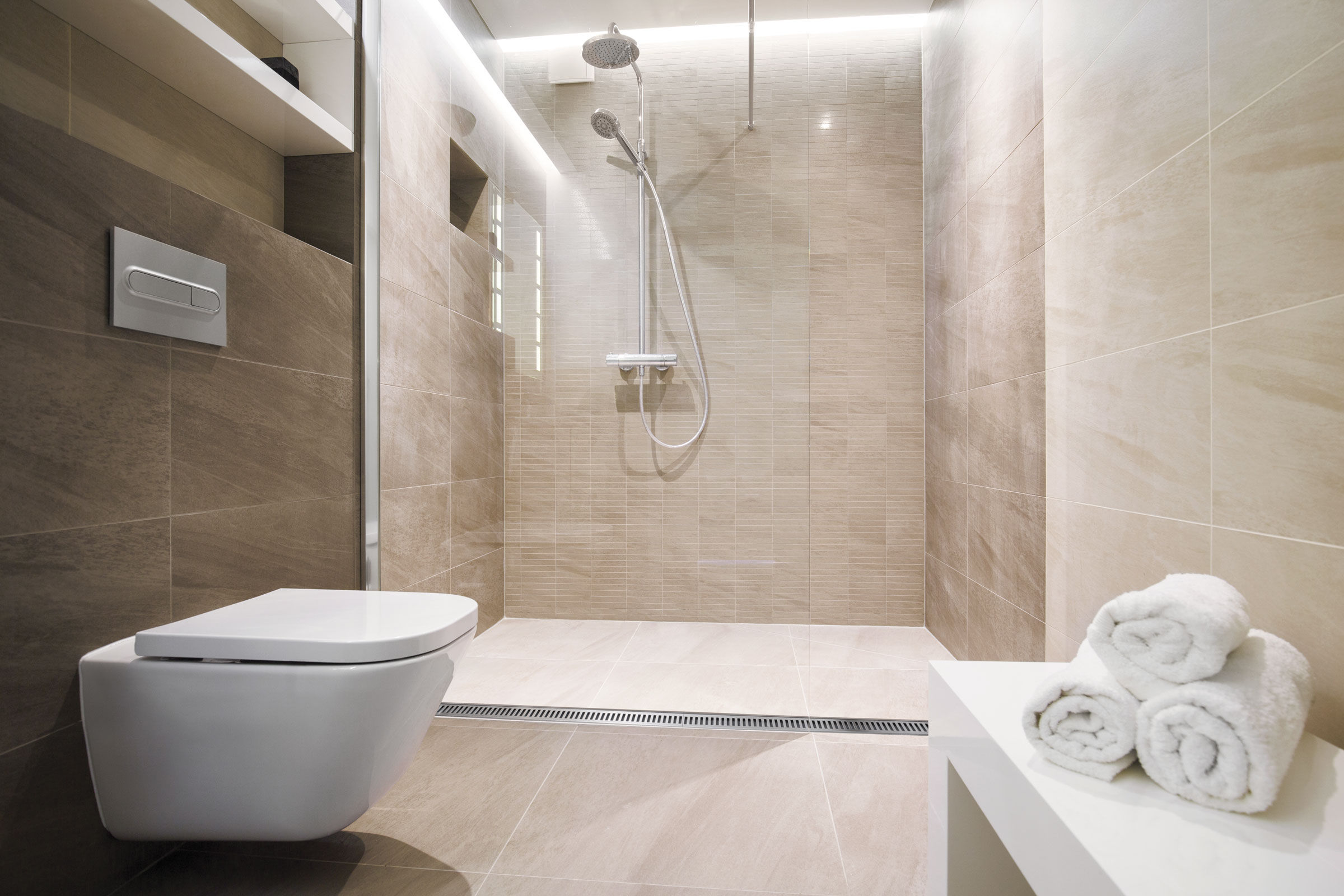
QuickDrain ShowerLine linear shower drain is seen here in a beautiful curbless shower. Photo courtesy of Oatey
Drain fixtures and systems are another area where conscientious material choices can help improve plumbing system sustainability. QuickDrain USA—a brand innovation under Oatey Co.—for example, uses 100% post-consumer recycled polyethylene terephthalate (PET) in all of their shower drain systems. “This environmentally friendly option is fabricated from recycled, plastic water and soda bottles,” Marlee Gannon, director of wholesale product and channel at Oatey, previously wrote for gb&d.
PET has a high strength and toughness as well as good heat and abrasion resistance, making it an ideal material for the conditions—that is, prolonged exposure to high temperatures and regular compression—shower drainage systems face on a day-to-day basis.
6. Tankless Water Heater

Switching to a tankless water heater eliminates the wait for hot water and helps reduce both water and energy waste. Photo courtesy of Oatey
A tankless water heater does not heat and store water in a tank but instead heats water as it is needed, either by way of an electric heating element or natural gas burner. Because they do not constantly heat water, tankless water heaters don’t generate the same standby energy losses that conventional storage water heaters do and are therefore much more energy-efficient.
The true efficiency of a tankless water heater depends on how much hot water a building uses in a day. A smaller household, for instance, or one that uses less than 41 gallons of hot water a day, can expect to use 24 to 34% less energy by switching to a tankless water heater. Larger households that use closer to 86 gallons of hot water a day, on the other hand, may only use 8 to 14% less energy—which still helps save money and energy in the long run.
This efficiency does, however, come at the trade off of a lower flow rate, which can make it difficult to supply hot water to multiple fixtures at once. Fortunately this can be mitigated by installing two or more tankless water heaters or by installing separate tankless heaters for certain appliances that require a large amount of hot water.
7. Recirculating Hot-Water Pump
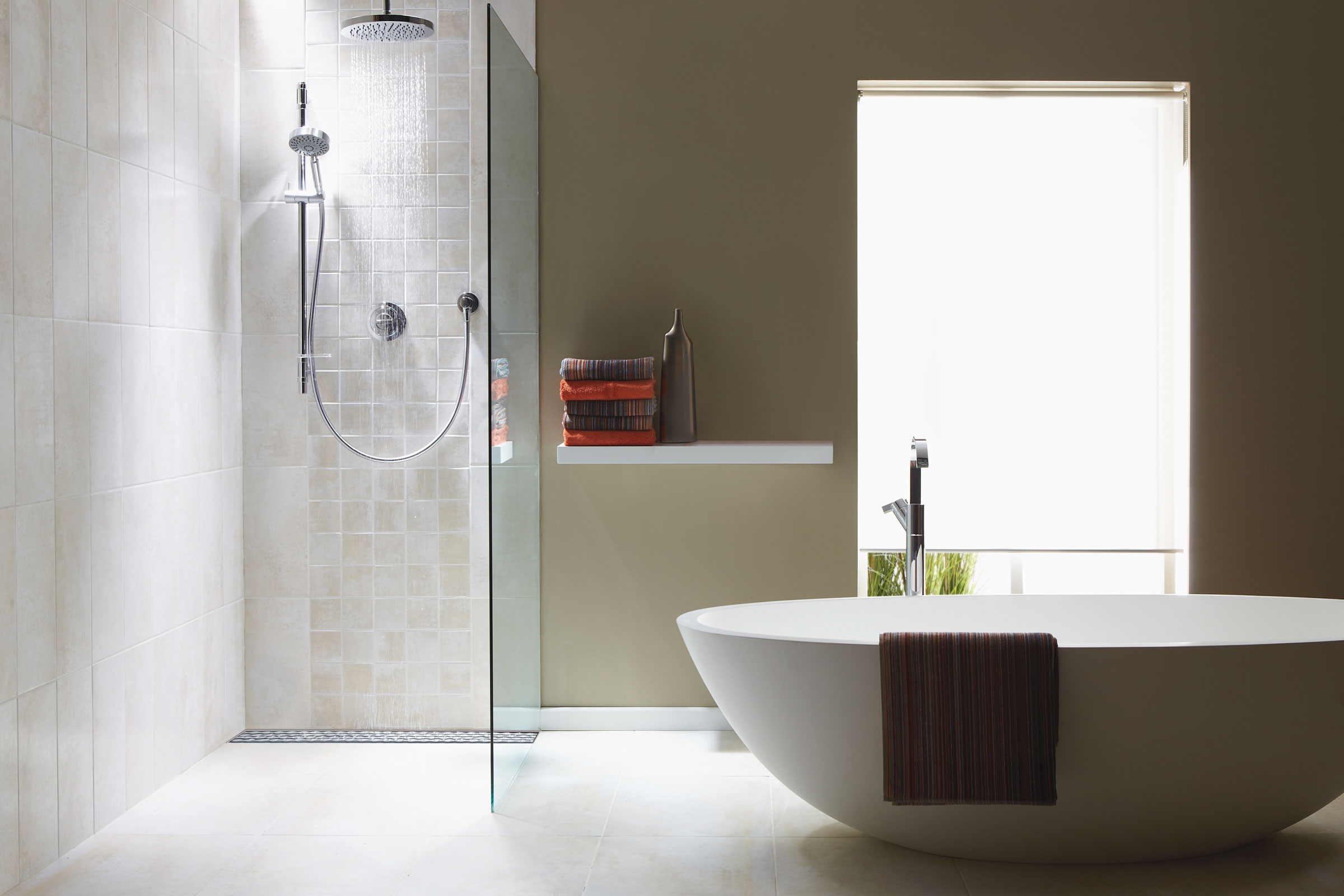
Recirculating hot-water pumps help reduce water waste by circulating cooled, static water that would otherwise be wasted in the wait for hot water to the farthest fixture before recirculating it back to the water heater via the cool-water line. Photo courtesy of Oatey
In most non-commercial buildings with one-way plumbing, hot water is pumped from a hot water heater and delivered to the appropriate fixture. Once that fixture is shut off, any excess hot water already in the pipes stays in the pipes and cools down over time, resulting in a warm-up period—rather than instant hot water—the next time the fixture is turned on. All of this cool, static water is then wasted in the wait for hot water.
Installing a recirculating hot-water pump eliminates this wait time and prevents water/energy waste by circulating water through the cooled pipes from the heater to the farthest fixture before recirculating said water back to the heater via the cool-water line. Such a system delivers hot water instantly, eliminates static water waste, and uses less energy than operating a 25-watt light bulb.
8. Pressure-Reducing Valves
Pressure-reducing valves automatically reduce the high unregulated pressure of incoming water to a lower, constant pressure that is better suited to residential and commercial water distribution. Most regional plumbing codes require that pressure-reducing valves be installed whenever the city main’s water pressure exceeds 80 psi, but they are recommended regardless of local regulations as they help to reduce water consumption and save energy.
In reducing water pressure pressure-reducing valves lower the rate of flow, resulting in less water being used to accomplish the same tasks. Lowering incoming water pressure by as little as 10 to 20 psi can save the average building thousands of gallons each year, drastically reducing operation costs. A lower rate of flow also means less energy is required to effectively heat said water, further reducing a building’s utility expenses.
Another benefit of pressure-reducing valves is that they help protect pipes and plumbing fittings from being damaged by high water pressure. Most plumbing fixtures and appliances are only designed to handle water pressure between 50 to 80 psi, but some municipal water lines pump water as high as 150 psi. Installing pressure-reducing valves greatly lowers the risk of leaks or breakage and increases the operational lifespan of plumbing system components, resulting in lower plumbing maintenance/repair costs over the system’s life-cycle.
9. Rainwater Harvesting
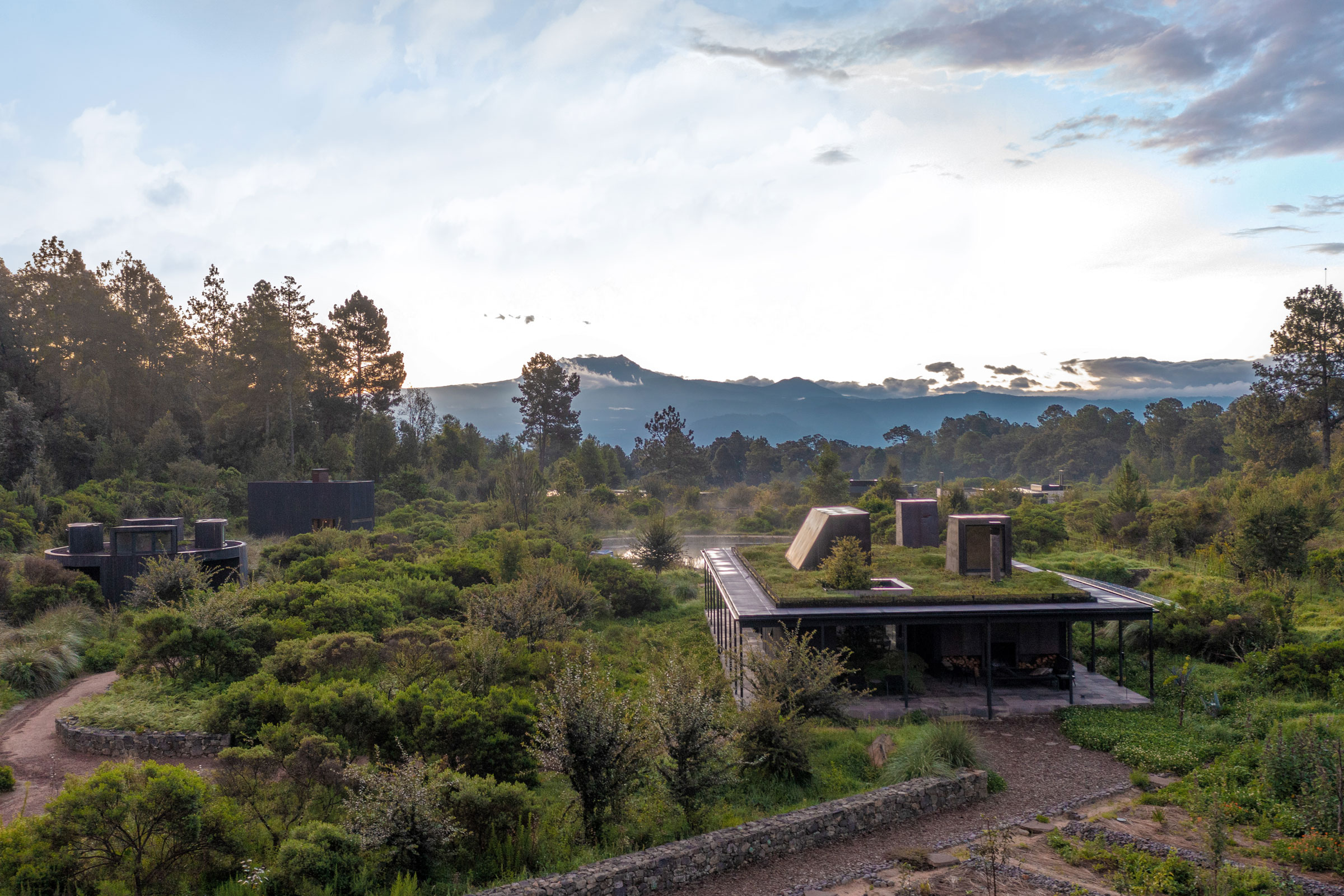
The Rain Harvest Home project is made up of three buildings that each collect rainwater to integrate with an above- and below-ground reservoir system. Photo by Jaime Navarro
Most modern buildings source their water from one of two places: a well or a municipal water treatment facility. There is, however, a third option that has seen a steady resurgence over the last few decades: the age-old practice of rainwater harvesting.
There exists several different types of integrated rainwater harvesting-to-plumbing systems, including:
- Gravity-only. Functions purely through gravity and require no energy to operate, as there is no pump involved; in order for a gravity-only system to work, however, rainwater can only be collected in containers that are located below gutter-level and above the outlets they feed into.
- Indirect-gravity. Operates similarly to gravity-only systems, but relies on a pump to first transfer the collected water to a high-level header tank, where it is then allowed to free-flow by way of gravity alone; indirect gravity systems are more versatile than gravity-only systems, as the main rainwater collection container does not need to be in an elevated position.
- Direct-pumped. Uses pumps to transfer collected rainwater from an underground storage tank directly to the point of use; direct-pumped systems may use either a submersible or suction pump, with the former being the most efficient and most popular.
- Indirect-pumped. Works similarly to indirect-gravity systems in that water is pumped from the storage tank to an internal secondary tank, but uses a booster pump instead of gravity to pressurize the water and send it through pipes; as a result, indirect-pumped systems can be located at any level in a building.
It is possible for rainwater harvesting to fulfill all of a building’s plumbing needs—as evidenced by the Rain Harvest Home in Temascaltepec, Mexico or the Urban Frontier House in Billings, Montana—but it is much more common for rainwater to replace 40 to 50% of a building’s mains water usage. This not only saves the building owner a large sum in utilities but also helps mitigate stormwater runoff and prevent sewer system overflow.
One of the most efficient uses for harvested rainwater is filling and flushing toilet tanks, as these systems typically only require a basic sediment filter—rather than full treatment or purification—before the water can be used. Rainwater-to-flush systems are incredibly simple in design and pump rainwater directly from a storage tank to the toilets themselves. There are also more involved rainwater plumbing systems that filter, treat, and purify collected water to supply a building’s faucets, showers, and appliances with potable water.
10. Gray Water Recycling
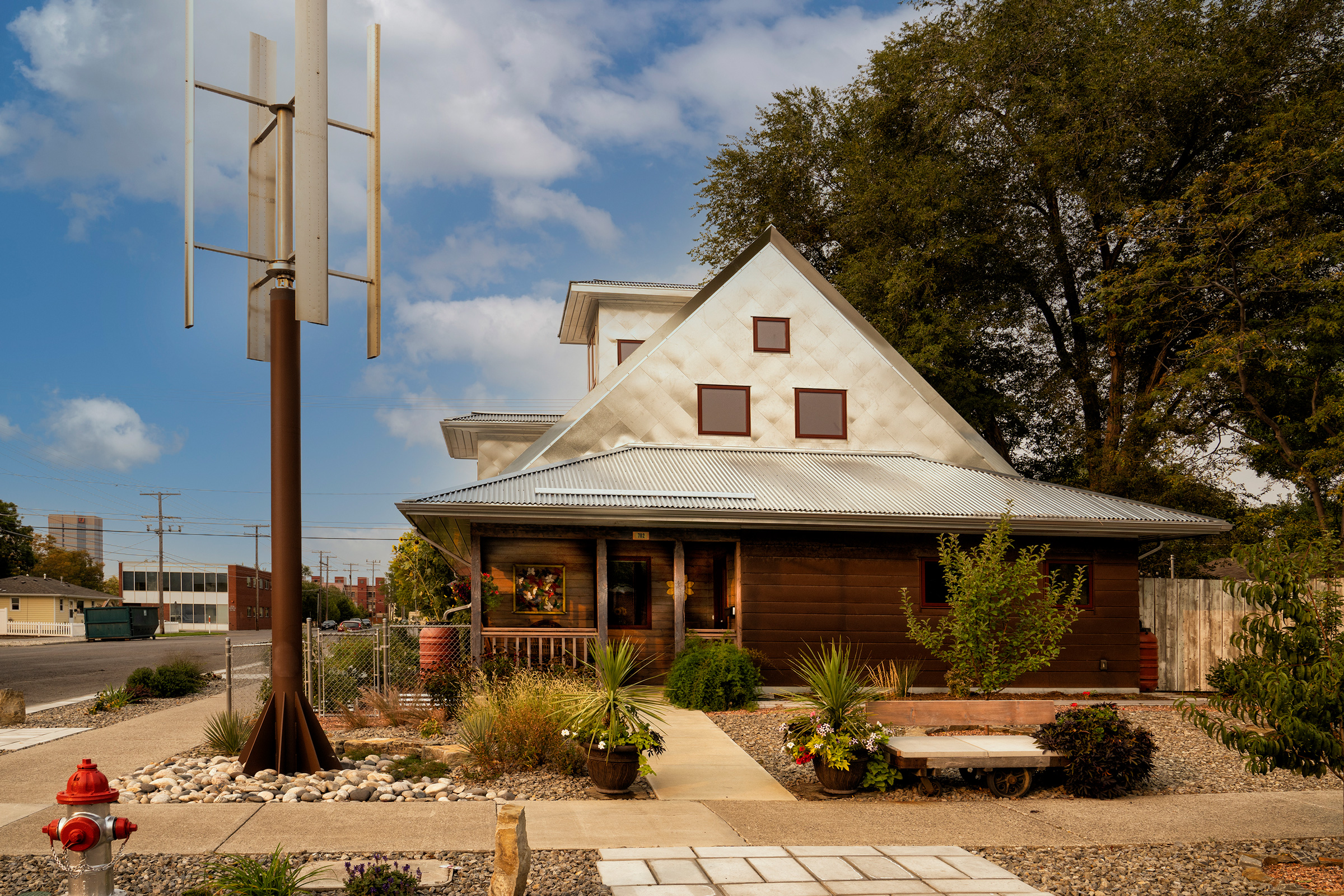
The Urban Frontier House in Billings, Montana recycles all of its gray water for use in toilets, the dishwasher, washing machine, and irrigation. Photo by Clark Marten
Wastewater from commercial and residential buildings is divided into two categories: gray water (wastewater from bathroom sinks, showers, and certain appliances) and blackwater (wastewater from toilets). Most homes and buildings dispose of their wastewater via a municipal sewer system or, in more rural areas, a septic tank that drains into a leach field. Gray water, however, can easily be recycled on-site to serve a myriad of landscaping purposes and may even be reintegrated into a building’s plumbing system.
One of the most common uses for recycled gray water is landscape irrigation, in which case the water is filtered through a multi-stage filtration system to remove hair, lint, and other impurities before being diverted directly to landscaping features or into sprinklers and/or drip-line irrigation hoses. Recycled gray water can also be reused to flush toilets, a common practice in commercial buildings or multi-family residential buildings with minimal irrigation requirements. Gray water-to-flush systems are, however, much more complex and require regular maintenance in order to work properly.
Blackwater can also be treated and recycled onsite but requires more advanced, intensive systems than gray water recycling. Most municipalities and zoning boards, however, have very strict regulations for—or simply do not allow—onsite blackwater treatment and recycling, as it carries a higher risk of pathogen transmission that may cause sickness or harm to the environment.


